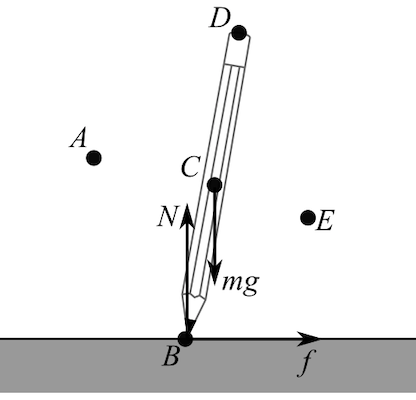Question
In: Physics
Which of the labeled points is the point that the axis of rotation passes through?
There are two reasonable approximations to consider for the pencil in this problem: a cylinder and a thin rod. However, in this problem, we will treat the pencil as a uniform thin rod of length 15.0 cm and mass 10.0 g.
The pencil rotates about an axis perpendicular to the plane of the figure. Which of the labeled points is the point that the axis of rotation passes through?
Solutions
Expert Solution
Concepts and reason
The concepts used to solve this problem are weight, center of mass, free body diagram, frictional force, and torque. First, use the concept of center of mass, weight, normal force, and friction force to draw the free body diagram of the pencil and show all forces that act on it.. Next, use the concept of the torque, and determine the point through which the axis of rotation for the pencil passes.
Fundamentals
Free body diagram (FBD): A free body diagram is a graphical representation of the applied forces and their resultant effect (also referred as reaction) on a body in a given condition. Normal force: It is defined as a contact force which is applied to the body against the net force on the body. The direction of the normal force is normal to the surface. Frictional force: The frictional force is a type of contact force which opposes the relative motion of the body. It is directly proportional to the normal reaction force. It always acts in the direction, opposite to the direction of motion. Torque: It is the rotational force on a body about a point. It is the product of the force and the perpendicular distance of the line of action of force from the center of the rotation. since the rotational motion of a body is defied about an axis of rotation, torque is also defined about an axis of rotation. Write the expression for the weight as, \(W=m g\)
Here, \(m\) is the mass of the object and \(g\) represents the acceleration due to gravity. The force due to gravity or weight of an object, always acts in vertically downward direction. Center of mass: It is the point on the body where whole mass of the body is assumed to be concentrated and thus the net weight of the body is assumed to act at the center of mass. The center of mass of the thin rod with uniform cross section is at the mid-span, that is, at the center of the rod.
The free body diagram of the pencil with the forces that act on it, is drawn as,

Here, \(N\) is the normal force, \(m g\) is the weight of the pencil, \(f\) is the friction force, point \(C\) is the center of mass of the pencil.
Draw the free body diagram of the pencil which touches the surface at point \(\mathrm{B}\). The normal force from the surface acts on the pencil at point \(\mathrm{B}\). The weight of the pencil acts in vertically downward direction at the center of mass of the pencil, which is at point \(C\). There is a friction force which oppose the motion of the pencil on the surface.
since the pencil touches the surface at point B, the weight of the pencil produces a torque and makes the pencil rotate about this point \(\mathrm{B}\), and this is the point through which the axis of rotation for the pencil passes.
The axis of rotation of the pencil passes through point \(B\).
The weight of the pencil acts in vertically downward direction at the center of mass of the pencil, that is, at point \(\mathrm{C}\). since, the pencil touches the surface at point B, the force due to weight of the pencil produces a torque and makes the pencil rotate about point \(\mathrm{B}\).
The axis of rotation of the pencil passes through point \(B\).
Related Solutions
Find the line that passes through the point (0, 1) and through the point of intersection...
Polarized light passes through a polarizing filter which has an axis of transmission oriented at θ1...
What is the proton's speed as it passes through point P?
For the following exercises, find the formula for an exponential function that passes through the two points given.
QUESTION 1: Two point masses are the same distance R from an axis of rotation and...
Unpolarized light passes through two Polaroid sheets. The transmission axis of the analyzer makes an angle of 21.0 with the axis of the polarizer.
Graph with x axis labeled Real GDP (billions of constant dollars) and the y axis labeled...
Unpolarized light with an intensity of 26.4 passes through a polarizer whose transmission axis is vertically...
Find the center and the radius of the circle whose graph passes through points (2,5) (-4,-3) and (3,4).
A thin uniform rod (mass = 0.420 kg) swings about an axis that passes through one...
- A child on a sled is travelling a total distance of 93 m down a dirt...
- Comparative financial statements for Weller Corporation, a merchandising company, for the year ending December 31 appear...
- 1) The provided file has syntax and/or logical errors. Determine the problem(s) and fix the program....
- Two stationary positive point charges, charge 1 of magnitude 3.05nC and charge 2 of magnitude 1.75nC...
- An engine operates with four essential variables controlling its operation. For the engine to be operating...
- Bonnie and Clyde are married and have purchased a comprehensive major medical policy which covers them...
- steam given inlet properties. It exits an isentropic turbine with a heat loss of 20 kj...
 Dr. OWL answered 4 years ago
Dr. OWL answered 4 years ago